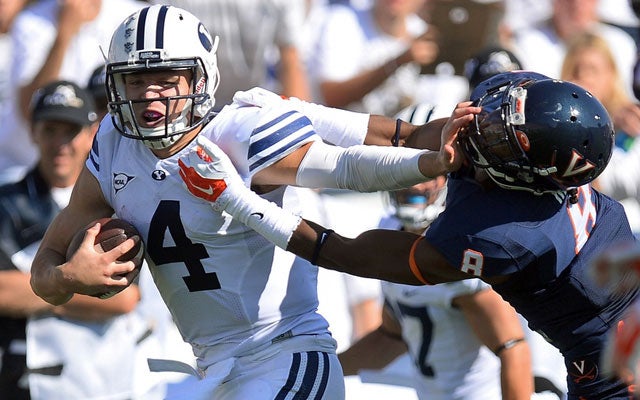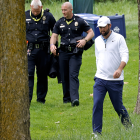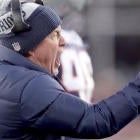Taysom Hill’s future is as bright as the sun splashing the nearby Wasatch Mountains.
If he does nothing else, BYU’s senior quarterback all but has a job locked up after football. That’s what a successful internship for a venture capital firm will get you. Hill loves the idea of one day seeding start-up tech companies with cash and flipping them to hungry buyers.
“It’s all extremely high risk,” he said.
Fitting because that’s a fair summation of Hill’s football career to date. Twice he has endured debilitating season-ending injuries. Hill blew out the lateral collateral ligament (LCL) in his knee as a freshman in 2012. Five games into a potentially record-breaking 2014, he was hit by the same Utah State player (!) and broke his ankle.
Despite the setbacks, Hill has retained his rep as one of the best running quarterbacks in the game. He enters 2015 as the only active FBS quarterback to be a career 2,000-yard rusher and 4,000-yard passer. Only seven other players in history -- one of them being Archie Manning -- have ever run for 100 and passed for 400 in a game.
Only five other quarterbacks have run for more yards in a game than Hill’s 259 vs. Texas in 2013. All that after missing 15 games the past three seasons.
“Of course you sit and wonder, ‘What if?’ Hill said. “I’ve certainly had conversations about that.”
With him, BYU might have been a New Year’s Six bowl team. Without him in 2014, the Cougars went 8-5 for the third straight season.
Internships and injuries in the rear view, Hill finds himself at the leading edge of a college football reorg. It’s not quite revolutionary but it is a disturbance in the football force. The running game has returned.
Last season, an all-time record was set nationally with teams averaging 4.46 yards per rush. The team average of 178 yards per game was the highest in 35 years. That number is up for the sixth straight year.
Hill and his running-quarterback peers are driving up the numbers. While the percentage of QB carries has increased only slightly since 2005, the impact of those runs have skyrocketed.
| Quarterbacks on the run | |
| Season | YPC (National) |
| 2005 | 1.85 |
| 2006 | 1.88 |
| 2007 | 2.23 |
| 2008 | 2.47 |
| 2009 | 2.44 |
| 2010 | 2.55 |
| 2011 | 2.56 |
| 2012 | 2.67 |
| 2013 | 2.86 |
| 2014 | 2.83* |
| * 10-year net increase of 53% | |
Average quarterback rush yards has nearly doubled in the last decade, according to research compiled by SportSource Analytics. Quarterback yards per carry are up 53 percent (1.83 in 2005, 2.83 in 2014).
Rushing yards gained by quarterbacks accounted for more than 15 percent of the national rushing yardage total last year. That’s up from 10.5 percent a decade ago.
It’s no secret why.
“The advent of the spread and the quarterback being a viable runner,” explained Utah coach Kyle Whittingham. “As a former defensive coordinator, that’s your biggest nightmare -- a quarterback who can hurt you both ways.”
In that defensive coordinator parlance, an offense that features a running quarterback is called a “plus one.” Simply put, the defense has to account for 11 players, instead of 10. Down through the ages, that hasn’t necessarily been the case. In the last 10-15 years with advent of spread offenses, it’s been the norm.
“You’ve gotta be pretty creative on defense,” Whittingham said. “You’ve got to be willing to play no deep at times, commit your safeties to the run game. All the sudden you do that and a guy like [Marcus] Mariota just torches you.
“The downside for an offense is you subject your quarterback to getting hurt. In college, it’s well worth it.”
| Rushing yards by QBs | |
| Season | % of total |
| 2005 | 10.57% |
| 2006 | 10.98% |
| 2007 | 12.23% |
| 2008 | 14.61% |
| 2009 | 14.18% |
| 2010 | 14.06% |
| 2011 | 14.38% |
| 2012 | 14.35% |
| 2013 | 15.73% |
| 2014 | 15.28%^ |
| ^ 10-year net increase of 44.6% | |
Don’t tell BYU that, though it is living with the consequences. Spread offenses have made quarterbacks more efficient rushing weapons.
Four of the last five Heisman winners have come from zone-read schemes. Two of them (Cam Newton, Johnny Manziel) ran for at least 1,400 yards. Combined, the four accounted for 40 percent of their teams’ rushing scores in their Heisman years.
Check a short list of fires starters for this modern age. Since 2000, West Virginia’s Pat White set the career quarterback rushing record (almost 4,500 yards); Colin Kaepernick ran for at least 1,000 yards three times at Nevada; and Northern Illinois rode Jordan Lynch to a 2013 Orange Bowl berth. Think about what Michigan would have been like without Denard Robinson. Tim Tebow sometimes played like a fullback under center for Florida.
In this century, it’s impossible to bow low enough to Texas’ Vince Young.
“The running game is arithmetic,” said analyst Chris B. Brown, proprietor of smartfootball.com. “Eleven guys on offense, eleven on defense. On every play the defense has one extra guy unblocked for the ball carrier.
“With the running quarterback, now you’ve neutralized that.”

Hill can’t wait to be the next ultimate “plus one.” In 2013, his only full season, Hill accounted for 4,282 yards. At BYU, only Ty Detmer, Steve Young and Jim McMahon were responsible for more yards in a season. Of that total, 1,344 came as the result of a bruising running style.
Texas is still trying to rinse itself of the shame of Sept. 8, 2013. BYU rushed for 550 yards in a 40-21 win, 259 of it by Hill.
“We see more safeties in the box, for sure,” Hill said. “That sophomore year, the No. 1 defense we played was playing Cover 1, man-to-man. They had some sort of quarterback spy. Last year that sort of changed.”
That’s because BYU’s up tempo spread offense was even more deadly. Defenses had to loosen up. Hill had rushed for 486 yards in 4+ games before going down with his injury.
The foundation for Hill’s 6-foot-2, 232-pound frame is a sturdy sequoia-like lower body. “Genetics,” he calls it. A 300-pound brother played on the defense line at Arizona State.
When Hill was knocked out for the second time by Utah State’s Brian Suite last year, he hopped off the field on one leg, rather than be carried off by teammates or trainers.
“You’re going to have to knock me out to make that happen,” he said.
For a guy named after a construction company, that fits the national toughness narrative for the rushing resurgence.
In five of the last six years, at least five quarterbacks have rushed for 1,000 yards. In the previous six years, there were more than three only once. Fifty-three players ran for at least 1,000 yards in 2014; that’s the third consecutive year at least 52 players have rushed for 1,000 yards. Nine averaged 130 yards per game; that’s the most to reach that mark since 2000 (also nine).
For the first time since 2007, at least two rushers surpassed 2,000 yards. The Big Ten monopolized that category with Heisman finalist Melvin Gordon (2,537) and Indiana’s Tevin Coleman (2,036).
Between 2006 and 2013, average rushing touchdowns per game increased almost 25 percent. The 15-year old single game rushing record was smashed in consecutive weeks in 2014 (Gordon and Oklahoma’s Samaje Perine).
“I saw a couple of guys rushing for 400 yards,” said venerable Oregon RB coach Gary Campbell. “Obviously, that kind of gets your attention.”
We’re coming off the third highest-scoring season ever (29.3 points per team). All-time highs have been set in 11 of 14 offensive categories tracked by the NCAA since 2007.
Only the game’s connoisseurs noticed a more subtle change. Balanced offenses were working the best.
Teams had to rely on the run more. As effective as the zone read spread was, there still had to be an ability to run the ball in the red zone where the field shrinks. In six of the last seven seasons, a team that has at least played for the national championship has finished in the top 13 in red-zone success.
Mike Leach’s Air Raid only went so far. There has to be balance. The year Sam Bradford won the Heisman at Oklahoma (2008), he was backed up by two 1,000-yard rushers (Chris Brown, DeMarco Murray).
From 2006-09, Oklahoma State’s offensive balance (run/pass) was never separated by more than 26 yards. The 2007 unit achieved football nirvana, perfect balance -- 243.15 yards per game in rushing and passing.
“The numbers show you have to be good at both,” said Dave Bartoo, the metrics-driven mind behind CFBMatrix.com. “You can’t have one without the other. The numbers tell me you must have a running game.”
No surprise, then, the No. 4 most balanced offense among the Power Five was national champion Ohio State.
The teams that are the most offensively efficient -- most points per minute -- win championships, Bartoo contends. He says the last seven national title winners have been in the top 10 in that category. Five of the last seven were No. 1.
“It kind of opened my eyes,” Bartoo said. “The game is approaching peak pace. The game can go only so fast without losing efficiency.”
What better way to improve efficiency than to run the ball? Teams that ran more often than passed on drives, scored 30 percent more often.
That led to the championship game showdown of Ohio State’s Ezekiel Elliott vs. Oregon’s Royce Freeman. The two high-school blue chips faced off against each other in that first CFP title game. Elliott responded with a career-high 246 yards and four touchdowns against Oregon. Freeman, a 1,000-yard rusher as a freshman, was held to 22.
One team played a third-string quarterback. The other had the Heisman Trophy winner behind center. It didn’t matter. The Buckeyes’ offensive line that had been embarrassed against Virginia Tech four months earlier, manhandled the Ducks for 296 rushing yards.
Three rushers who led Power Five conferences return in 2015. Oklahoma’s Perine became the single-game record holder as a freshman with 427 yards against Kansas. New Pittsburgh coach Pat Narduzzi gets back junior James Conner. UCLA’s Paul Perkins (1,575 yards) became the first Bruin to lead the Pac-10/12 in rushing in 13 years.
Georgia has pumped out tailback like they were Camrys on an assembly line. Sensational freshman Nick Chubb stepped up to rush for 1,500 yards in Todd Gurley’s injury/suspension-derailed final season.
Wisconsin has gone to Rose Bowls and won Big Ten titles developing tailbacks and intimidating offensive lines to spring them. The Badgers have set the NCAA record for tailback duo rushing the past two seasons. In 2013, Gordon and James White piled up 3,053 yards. Last season Gordon and Corey Clement went for 3,536 yards. That was more than 119 teams.
If new head coach Paul Chryst doesn’t mess it up, Clement should step right in to replace Gordon. Arkansas’ Bret Bielema is trying to recreate his Wisconsin success down South.
Urban Meyer’s teams have finished out of the top 25 in rushing only twice since Florida’s national championship year in 2006.
“In a spread offense, sometimes they open up bigger running seams,” said Boston College coach Steve Addazio, a former Florida assistant under Meyer. “Option football has always created bursts. It used to be just military academies [running that option]. Urban’s philosophy is to run the football. You get in the red zone. If you can’t get it in, you’re at a deficit.”
Ohio State was a middling 83 percent in red-zone conversions before December. Down to their third-string quarterback, Meyer’s Buckeyes then scored on 13 of 14 red-zone possessions in their three-game championship run.
Hill originally signed with Jim Harbaugh at Stanford when the offense was being remade -- a pro-style attack with resilient physical backs. That created the modern Stanford “brand.”
Arriving in 2013, Addazio inherited Andre Williams, who led FBS in both carries and yards (355 for 2,177). More than the philosophy changed – BC went from 2-10 to 7-6.
“Stanford really caught my eye years back when Jim Harbaugh went back to that, the two-back power game. It’s different,” Addazio said.
All of it reflects an ongoing truth about the spread-option offense: It can be a launching pad for power running. Just don’t ignore the quarterback.
“I’m very excited,” Hill said. “Let’s pick up where I personally left off last year.”




















